For the majority of the time since he moved to the EPL and became Tottenham Hotspur’s club-record signing in the summer of 2019, ex-Olympique Lyon midfielder Tanguy Ndombele has struggled to hit the same level of performance that he managed to hit during his time Ligue 1.
The Frenchman rarely started during his first season in north London and it didn’t take him long to draw the ire of Spurs boss Jose Mourinho, with the Portuguese coach calling Ndombele’s fitness into question last term.
However, Mourinho has changed his tune somewhat this season as he has already been full of praise for Ndombele and the signs of improvement that he has shown for the Lilywhites at the start of the 2020/21 campaign and the addition of Denmark international Pierre-Emile Højbjerg to Tottenham Hotspur’s midfield has played no small part in the Frenchman’s upturn in form.
In this tactical analysis piece, in the form of a scout report, we will look at how Højbjerg has influenced José Mourinho’s tactics, pertaining to Spurs’ midfield and this tactical analysis will look at how he has had impacted Ndombele’s game, in particular, since moving to north London from Southampton during the summer.
Statistical analysis of Højbjerg’s impact on Spurs’ tactics in possession
We are just four games into the 2020/21 Premier League campaign, which is still very early days for this season, however, there have been some noticeable differences to Tottenham’s game this term and new midfield man Højbjerg has been pivotal to those differences.
Firstly, Spurs have been more patient with the ball this term. In the Premier League, they have kept more possession, in general, thus far in the 2020/21 campaign than they did last season, as they have kept an average of 55.2% possession in their opening four games of this league season, while they kept 51.1% of possession in England’s top-flight last season.
Additionally, this rise in possession has been accompanied by a rise in passes, as Tottenham have completed 493.85 passes per 90 this term, whereas they completed 425.06 passes per 90 in England’s top-flight for the 2020/21 campaign.
Højbjerg’s passing ability has been central to Spurs’ increased average percentage of possession and their increase in passes played per 90 so far this season.
Last season, in the league, Harry Winks – who played a similar role to the one Højbjerg currently plays for Spurs in a handful of games under Mourinho – played more passes per 90 of any Tottenham player, with 59.7 and a pass accuracy percentage of 90.7%.
However, Højbjerg has surpassed that significantly so far this term, as he has played an average of 76.85 passes per 90, with a 92.19% pass success percentage. The ex-Southampton man has not only played more passes than any other Tottenham player this season, but he has also currently played more passes (333) than any other player in England’s top-flight this term.
So, Højbjerg has evidently been an important player, in possession, this season for the Lilywhites but he contributes for his side in more ways than just ball retention – he also plays a key role for his side in terms of ball progression.
In addition to surpassing Winks’ average number of passes per 90 this term so far, Højbjerg has also surpassed the Englishman in terms of passes to the final third per 90, so far this season.
Winks played more passes to the final third (10.43) than any other Tottenham player last season and 85.3% of his passes played into the final third were accurate.
However, Højbjerg currently leads the Lilywhites in this statistic for the 2020/21 Premier League campaign, as he has played 11.54 passes to the final third so far this season and 90% of his passes to the final third have been accurate, with only four other Premier League players having played more of their passes into the final third accurately at this stage of the campaign.
Furthermore, Højbjerg currently leads England in terms of the overall total of passes he has played to the final third (50) so far this season.
These statistics give us a good idea of Højbjerg’s importance to Tottenham’s tactics in possession and it’s somewhat clear that he has played a significant role for them in keeping more of the ball and in progressing the ball into more dangerous areas of the pitch this season.
Spurs have adapted to a more possession-based style this season so far and Højbjerg has been important in helping them to do that. This change, which has come with heavy influence from Højbjerg, has had a significant impact on Ndombele’s game.
Højbjerg’s positioning
Last season, Ndombele was often benched for Spurs but when he did play, he occupied a variety of different positions and struggled to really nail down a place in the squad for himself.
He sometimes played as the deepest of three central midfielders, he sometimes played as the most advanced of three central midfielders and he sometimes played somewhere between the two.
Ndombele has been deployed quite deep to a large degree of success throughout his career, however, with the arrival of Højbjerg at Spurs, the Frenchman has played far more frequently in a more advanced midfield role and he has impressed in this position, with his performances in this role resulting in him receiving high praise from the same manager who had been publicly criticising him just months prior.
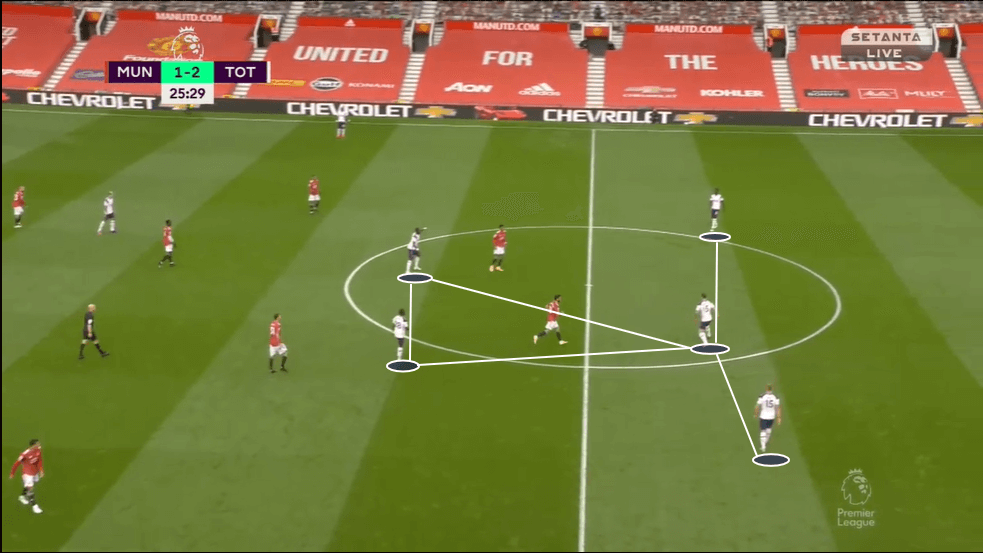
This image above shows us an example of Spurs’ shape during the build-up with both Højbjerg and Ndombele on the pitch, while Moussa Sissoko rounds out the midfield three in this particular example.
Here, we can see Spurs forming a ‘3-2’ shape with their backline and their midfield line, during the build-up. This has been a fairly common feature of Spurs’ build-up throughout Mourinho’s time in charge at the club.
We can see that Højbjerg, who is on the ball here, has dropped deep, in between the two centre-backs with the two progressive passing options – one of whom is Ndombele – positioned ahead of him.
While Spurs have formed this structure in the build-up somewhat frequently under Mourinho, it has been particularly successful with Højbjerg at the centre of it, due to his quality ball-playing ability and this has also resulted in Tottenham keeping more of the ball of late, as Højbjerg is more of a patient player who enjoys playing short passes, than someone like Eric Dier, who played this particular role on some occasion last season.
This has then seen Tottenham play through their midfield more often and as a result, when on the pitch, Ndombele has seen more of the ball. The 23-year-old has actually received an average of 50.05 passes per game this season, while he received only 37.69 passes per game last season which gives us an indication of just how much more involved he has become this term with Spurs’ tactical alterations, as does his increased average of 64.86 passes played per game in the 2020/21 season so far, compared to his average of 49.97 passes per game in the 2019/20 campaign.
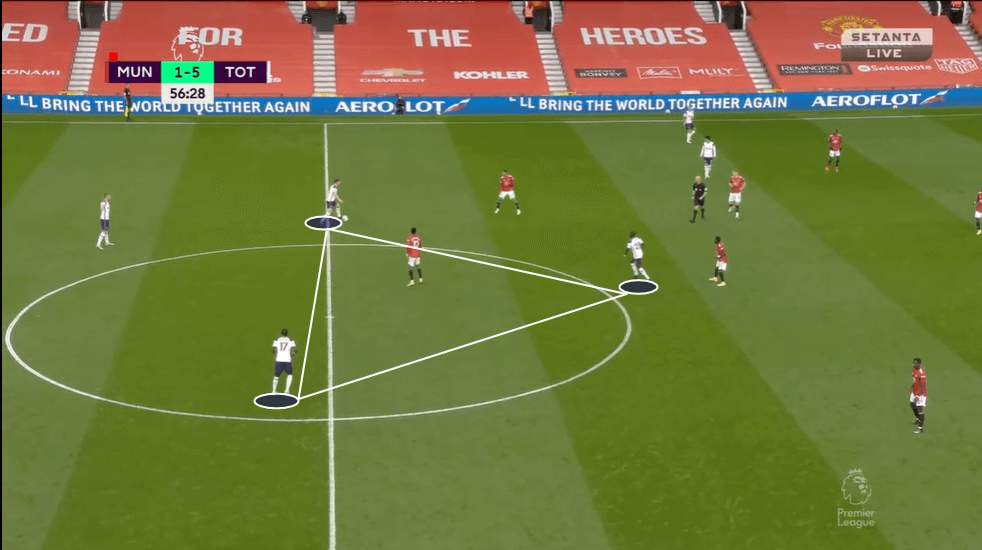
At times, such as when winning comfortably in this recent Premier League clash with Manchester United, Spurs have switched from utilising Højbjerg as a single-pivot to using him as part of a double-pivot, however, as we can see here, even when making that switch, Ndombele remained the most advanced of the three central midfielders, with teammate and compatriot Sissoko joining Ndombele in the slightly deeper position.
This then sees Ndombele continue to operate quite similarly to how he had been previously during the build-up, in the sense that he would occupy a position just in between the opposition’s front line and midfield lines, however, now, he occupied a more central position while before he had been positioned slightly to the left side of midfield, where he has spent the majority of the season.
So, simply in terms of positioning, it certainly seems as though Højbjerg has had an impact on how Ndombele has been used in the side this season, with the Frenchman spending far less time in deeper positions and more time in advanced midfield positions.
Additionally, it seems that the change that has occurred in Tottenham’s style of play that has come along with Højbjerg’s arrival has been quite successful at getting Ndombele more involved in the game in these advanced positions compared to last season.
When you consider that Ndombele has enjoyed more success with his dribbles (87.5%) than he did last season (66.7%), he has made more forward passes per 90 (20.91) than he did last season (15.43) and has made 1.88 touches per 90 in the penalty area this term compared to 0.97 the season before, perhaps this greater involvement may have had a positive impact in some areas for the player.
Højbjerg creating space for Ndombele
If Højbjerg has helped Ndombele to improve his numbers in these areas, one of the ways in which he has surely helped the Frenchman to succeed in terms of his dribbling, his progressive passing and his involvement in the penalty area, is how he’s managed to create space for the 23-year-old before playing the ball to him in a variety of different, yet effective, ways.
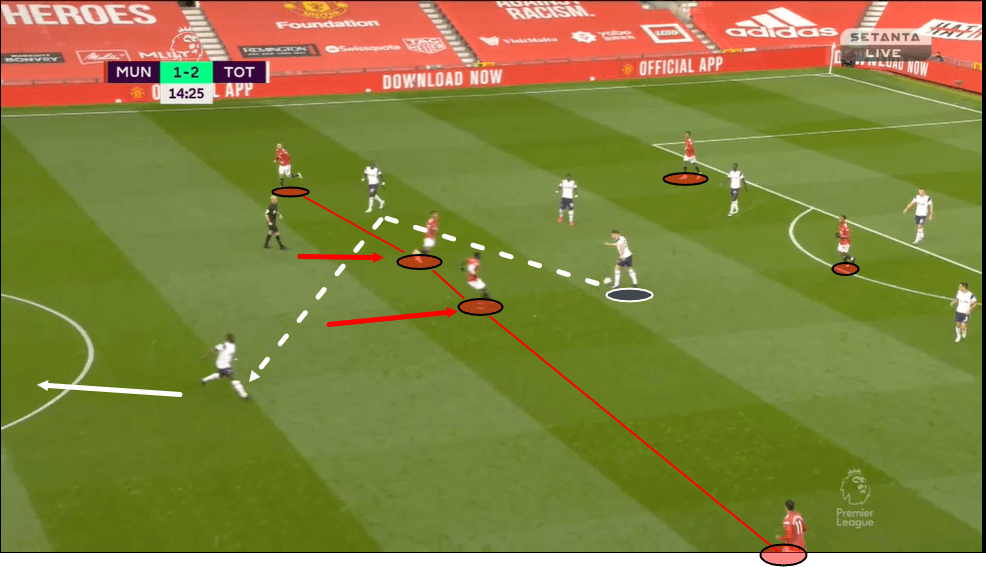
Firstly, this image above provides us with an in-game example of holding midfielder Højbjerg attracting pressure from Manchester United’s midfielders.
Two Red Devils midfielders can be seen pressing the Danish midfielder high up the pitch here, while United’s wingers also both seem to be in line with those two pressing central midfielders. Additionally, we can see two Manchester United forwards behind Højbjerg in possession here, though they didn’t apply much pressure to the midfielder on the ball.
So, we can see Højbjerg on the ball in between the Red Devils’ first and second line of pressure and with a lot of room for his side ahead of him in between the Red Devils’ midfield line and their backline, with Spurs’ opponents not defending very compact at all here and leaving lots of space for Ndombele to move into in order to potentially exploit, should Højbjerg be able to get the ball past this Man United press he is facing.
As this particular passage of play moves on, we see Højbjerg hold onto the ball for a moment, drawing these pressing Man United players in further before fairly nonchalantly lifting the ball over them and finding Ndombele in a lot of space between the opposition’s midfield and defensive lines. From here, the midfielder can take it into the final third.
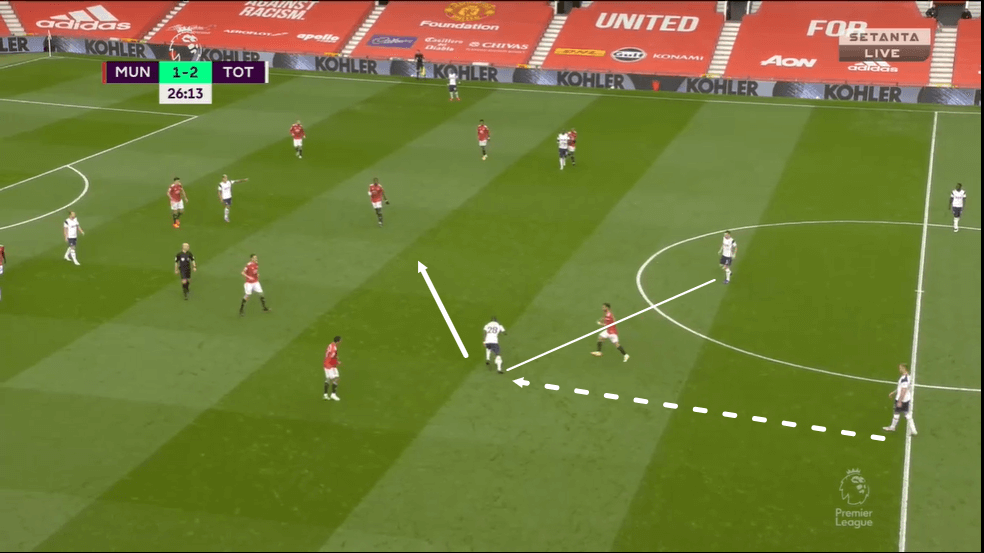
This next image shows us another example of how Højbjerg has helped to create space for Ndombele during the build-up – on this occasion – via his positioning.
We already touched on Spurs ‘3-2’ shape at the beginning of their build-up structure. As the play advances further up the pitch into the opposition half, however, Højbjerg advances slightly further up the pitch and into this position we can see him occupying here, directly in between the two centre-backs and the two central midfielders.
So, this game the lone opposition striker a dilemma when left centre-back Dier was in possession of the ball, as he was outnumbered 2v1 by the two Spurs midfielders here and ultimately ended up marking neither of them, thus allowing Dier to play the ball directly into the feet of Ndombele who, as we can see, has got a decent amount of space around him here, in part, thanks to his teammate Højbjerg’s positioning and how it made it difficult for the opposition to cover these progressive passing options.
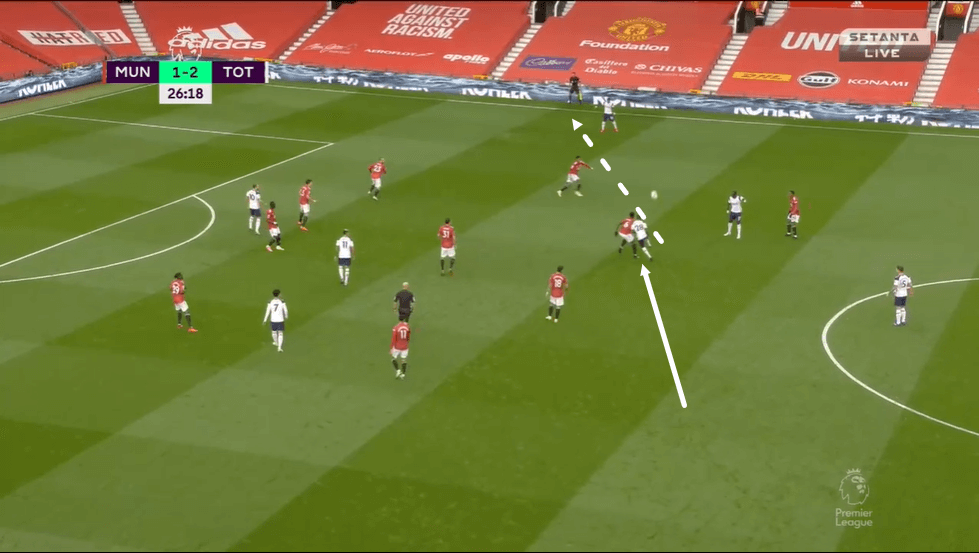
As this passage of play then continues, as Ndombele receives the ball, he quickly turns and drives forward in possession, carrying the ball deeper into the opposition’s half, before he goes on to advance the play into the final third by playing the ball out wide.
So, we can see that this bit of space that he was afforded prior to receiving possession was key for him to get the ball and then successfully carry it forward to play it into a more advanced and potentially dangerous area.
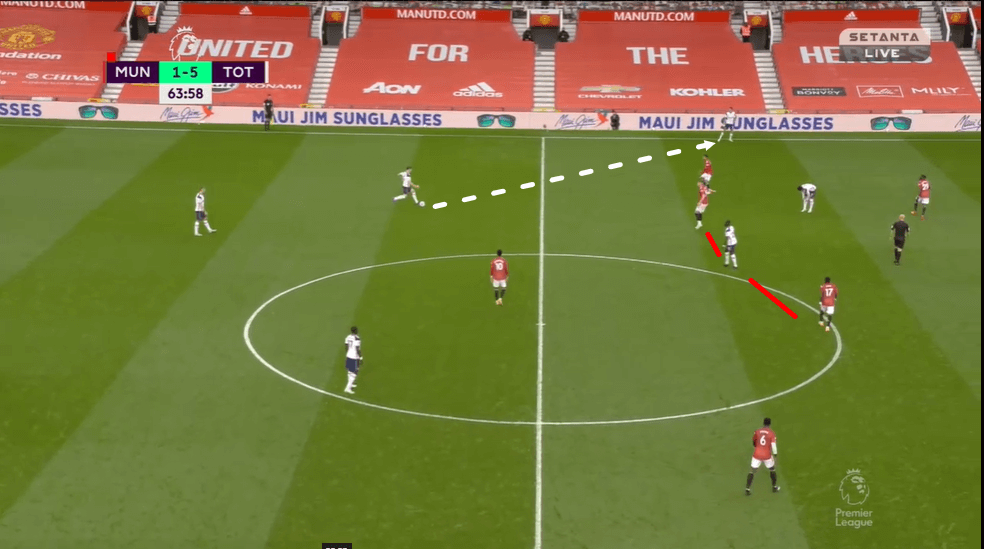
Meanwhile, Højbjerg also creates space for Ndombele by manipulating the opposition’s defensive shape through his passing. We can see an example of one such occasion when the Dane did this in this image above, where Højbjerg spreads the ball out to the left-wing from his left-sided central midfield position.
He often plays the ball out to the wing from his central midfield position, especially when the play often tends to run through him, but the opposition will generally try to primarily protect the centre of the pitch in their defensive shape and that is certainly the case here, as we can see one opposition player maintaining a very close position to Ndombele on the right side – seemingly ready to pounce should the ball be played into him – while another opposition player also stayed quite close to him on his left, providing some extra cover should Højbjerg play the ball to him on that side.
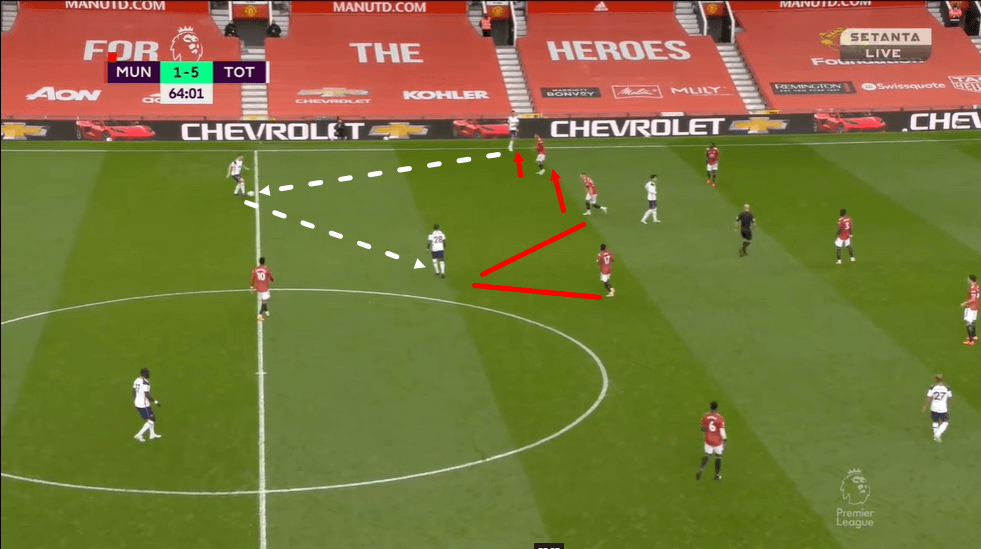
However, as we can see here, the opposition’s defensive shape is altered greatly by this pass out to the left-wing, as they move to close down the wide man before he simply breaks down the wing.
The wide man is prevented from carrying the ball forward, however, he is able to play the ball straight back to Højbjerg and now, as we can see in this image, there is a lot more space for Ndombele in the centre and as play moves on from here, we see the midfielder collect the ball from Højbjerg.
It is fair to say that in addition to his technical ability on the ball, this passage of play shows us an example of how Højbjerg’s intelligence has had a positive impact for Spurs and, ultimately, Ndombele as he benefited from the Dane’s quick thinking here to manipulate the opposition’s shape and create space for him in the centre which he then went on to exploit just seconds later.
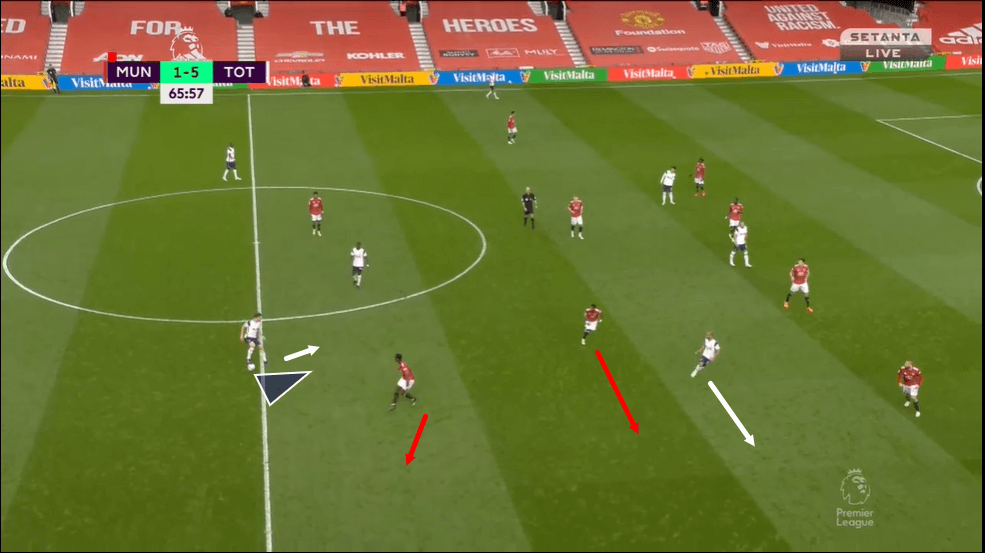
As well as passes, Højbjerg has created space for Ndombele via his body positioning and we can see this in action in this image above. Just prior to this image being taken, Højbjerg opened his body up to the wing, where an overlapping full-back is positioned.
This movement prompted the opposition to start shifting out wide to this position but, then, Højbjerg quickly turned back inside to play the ball to Ndombele, who was now enjoying an increased amount of space, thanks to this little movement that dragged opposition players out wide and opened up the centre of the pitch enough for the Frenchman to get on the ball, turn and attack the opposition’s goal.
As can be seen in this section of analysis, there are a variety of ways in which Højbjerg has created space for Ndombele to get forward and create during his time with the club thus far and this has surely played an important part in Ndombele’s greater dribble success and increased number of forward passes.
Højbjerg as a backwards passing option for Ndombele
So, we’ve discussed how Højbjerg’s progressive passing ability can help get Ndombele on the ball more often and we’ve talked about how Højbjerg has seemingly helped Ndombele to make more forward passes this term, however, Højbjerg also often serves as a backwards passing option for his 23-year-old midfield teammate
It’s not always a bad thing to pass backwards and considering that we’ve established they’ve kept a good chunk more possession this season than they did last season, it mightn’t come as a surprise to many that Ndombele has utilised Spurs’ new holding midfielder as a backwards passing option at times this season.
One common criticism of Ndombele last season was that he took too much out of the ball at times, resulting in some unnecessary turnovers and perhaps one of the reasons for his improved dribbling success this term has been the fact that Højbjerg has provided him with an option to release the ball backwards, at times, when being pressed aggressively.
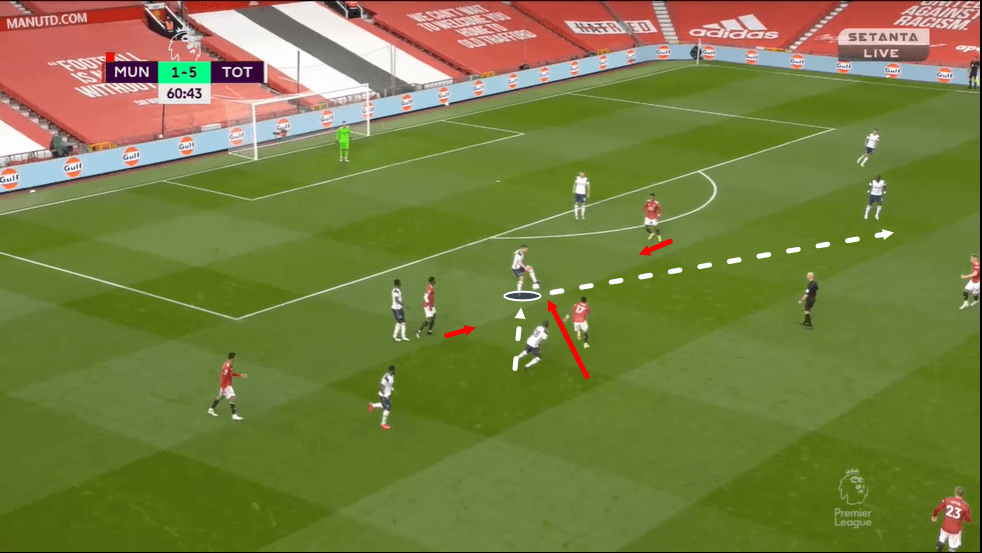
One example of this can be seen in the image above. Just prior to this image being taken, Ndombele was put under some pressure from an opposition player, however, instead of backing himself to take the ball past the player himself and risking allowing a turnover deep inside his own half, Ndombele simply finds Højbjerg, who is comfortable receiving the ball under pressure and showcases that ability by dealing well with this particular situation.
He receives the ball well on his left foot, opens his body up away from the pressing opposition player and quickly plays a pass to teammate Sissoko who then plays the ball on out to the wing, getting past a couple of lines of pressure in the process and actually setting up a potentially dangerous counterattacking situation for Spurs.
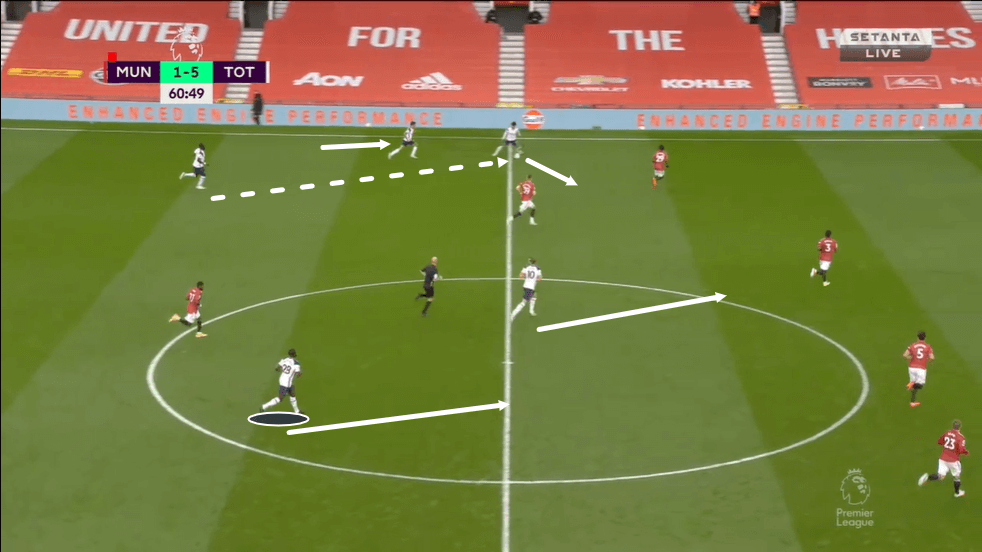
Here, we can see the situation that Spurs end up in after playing past the opposition’s aggressive press and in the centre of the pitch, circled here, we can see Ndombele now in a much more favourable situation than the one he found himself in at the very start of this move, so this shows us the importance of the role Højbjerg plays as a holding midfielder in terms of getting himself into space and making himself available for these backwards passes in order to quickly get the attack going again.
Additionally, the player’s impressive technical ability evidently comes in useful here as well as his intelligence and this combination was pivotal for getting this attack started.
How Højbjerg’s defensive contribution helps Ndombele
Højbjerg’s on the ball ability is clearly a big part of his game and a big part of how he has been helpful for Ndombele during his time with Tottenham however, Hojbjerg is also a huge asset for his side off the ball and this may also have helped Ndombele to a large extent this season.
As mentioned previously, Winks and Dier were probably the primary options for Spurs in the role that Højbjerg currently plays last season and during the 2019/20 campaign, Winks engaged in 6.81 defensive duels per 90 with a 51.1% success rate, while Dier was slightly more impressive, having engaged in 6.96 defensive duels per 90 last term with a 64.91% success rate.
This is another record from last season that Højbjerg has smashed so far during the 2020/21 campaign, for Spurs, as so far this season, the Dane has engaged in 9.92 defensive duels per 90, with a 53.49% success rate.
Additionally, Højbjerg has made 4.62 interceptions per 90 so far this season, which is also slightly more than either Dier or Winks made last term.
So, this would indicate that Højbjerg’s defensive contribution is greater than that of Winks and Dier and this may have taken some of the defensive burden off the shoulders of Ndombele this season.
Last term, Ndombele engaged in 6.42 defensive duels per 90, with a 54.8% success rate. However, this season, Ndombele has engaged in less defensive duels per 90 – 4.93 – but with 61.9% of his defensive duels coming off successfully. Meanwhile, Ndombele made 6.67 recoveries per 90 last season, 45.8% of which were made in the opposition’s half, while this season, the 23-year-old has made a similar number of recoveries – 6.58 – but with 67.9% of them coming in the opposition’s half. This might suggest that Højbjerg’s defensive contribution has allowed Ndombele to focus more of his defensive efforts higher up the pitch and not have to do as much deep defensive work.
Højbjerg is an aggressive player off the ball. As the holding midfielder, he tends to defend the area between Spurs’ midfield and defensive lines when defending deep but he likes to defend high up the pitch too during earlier stages of an opposition attack.
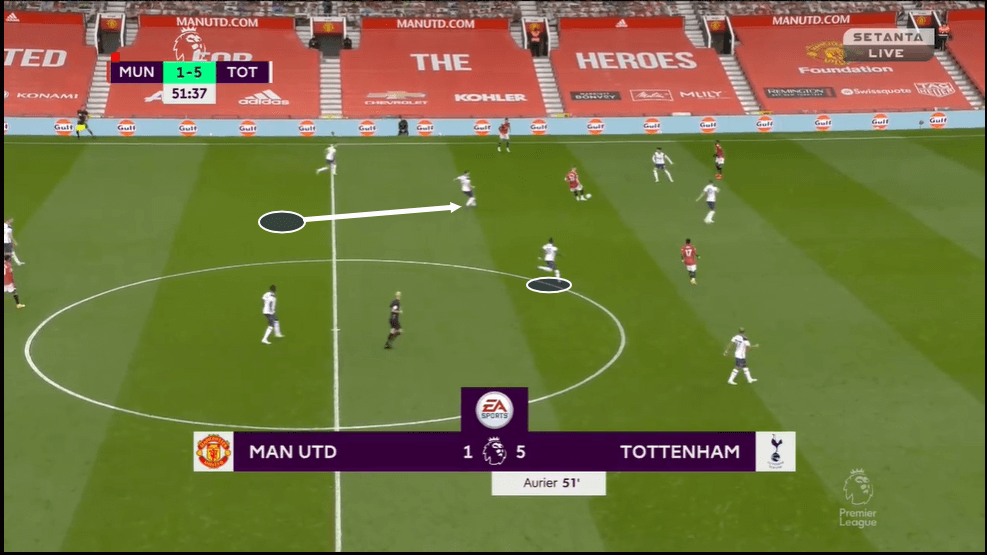
This image above shows us an example of Højbjerg defending aggressively high up the pitch, pressing this opposition player as they receive the ball well inside their own half from a defender. This prevents them from turning and playing the ball into Spurs’ half of the pitch, while this aggressive movement from Højbjerg also allows Ndombele to stay central and pick up another man, thus cutting off that potential passing option too and making it even harder for this ball-carrier.
In addition to the fact he does have impressive technical defensive ability and he is strong at reading the game, Højbjerg is a very mobile midfielder and so, that does take some of the risk out of this aggressive press because there is a chance he can recover even if he is beaten. His level of mobility also allows him to cover plenty of ground in a given match, which may be another reason for his high number of defensive duels.
He is a disciplined player, he doesn’t press for the sake of it and he does tend to primarily defend in his own half between the midfield and defensive lines, however, he is comfortable defending higher up the pitch and will often be seen doing that too, in situations like this where it is seemingly of benefit to his side, which is evidently of benefit to Ndombele on occasions like this.
Conclusion
So, to conclude this tactical analysis piece in the form of a scout report, Hojbjerg has been a successful addition to Spurs’ midfield and the Dane has already made a very noticeable impact on the Lilywhites’ overall game, which has, in turn, seemingly had a positive impact on plenty of his teammates – Ndombele included.
The Frenchman has performed in a more advanced role and has enjoyed more of the ball this term, while his new midfield partner has put up some impressive numbers on and off the ball to help his side, and Ndombele, make some positive strides this season already.





Comments